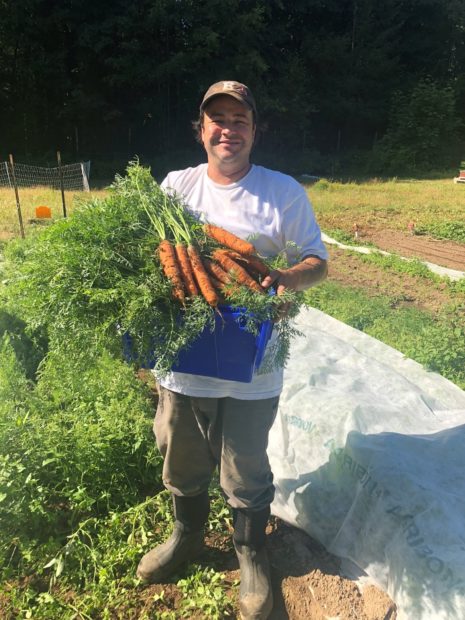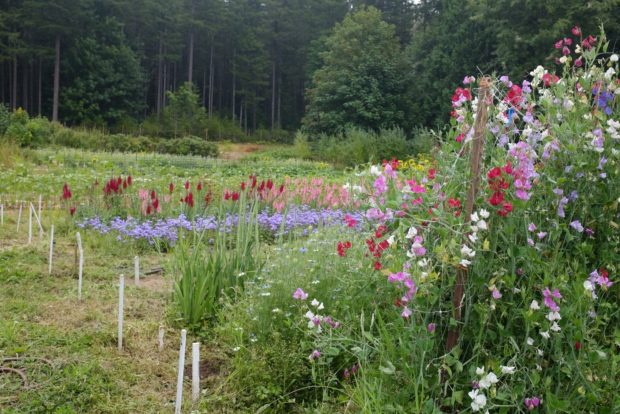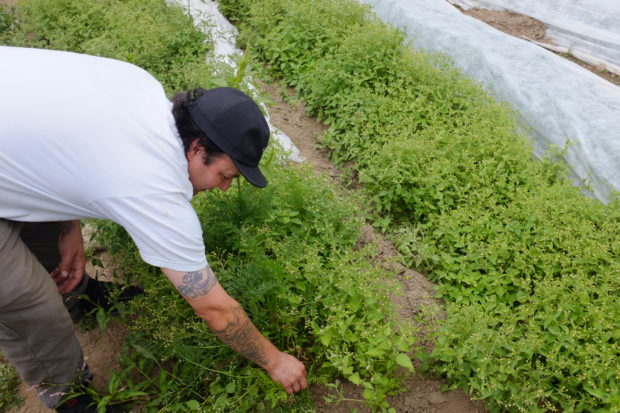Text by Bethany Shepler, SPP Green Track Program Coordinator, and Joslyn Rose Trivett, SPP Education and Outreach Manager.
Photos by Bethany Shepler, except where otherwise noted.
About a year and a half ago, SPP partners hosted a beekeeping summit at Washington Corrections Center for Women (WCCW). Nearly every facility was represented and we were joined by Washington State Beekeepers Association (WASBA) leadership, local beekeeping clubs, and state agency pollinator enthusiasts and experts.

Group photo from the Beekeeping Summit in Spring 2017. Photo by Ricky Osborne.
The summit was well timed to meet growing interest in bringing beekeeping to prisons around the state. A few WA prisons have hosted beekeeping for years and SPP partners were hearing inquiries from many others interested in starting new programs. SPP Co-Director Steve Sinclair suggested a summit, and that was the catalyst we needed; it brought everyone together to learn from each other, expand practical knowledge, and build enthusiasm.
The effects of the summit are still being felt around the state. A year and a half later, WA Corrections is part of 13 active beekeeping programs, and all 10 of the new programs are doing well. Some facilities are conducting scientific trials and learning about honeybee forensics. This fall, Washington State Penitentiary (WSP) and Airway Heights Corrections Center (AHCC) participated in a USDA national survey on bee health.
Each program is worthy of its own article. Here, we will share just one or two highlights from each. Check out all of the incredible accomplishments of beekeepers in prisons:
Airway Heights Corrections Center (AHCC)

AHCC has one of the fastest growing beekeeping programs in Washington prisons, and the first to create their own bee club. Working with West Plains Beekeepers Association, incarcerated beekeepers created the first draft of a new, state-wide Journeyman course manual, pictured above—a stunning accomplishment. Currently, Washington State Beekeepers Association is refining AHCC’s draft for publication, for both prison and non-prison programs! We are ecstatic to see the support and excitement AHCC has shown for their beekeeping program and look forward to their continued success!
Clallam Bay Corrections Center (CBCC)

Clallam Bay hosted its second beekeeping intensive this spring. Students had already completed the Beginner Beekeeping modules, and prepared further by reading books and scientific articles. Mark Urnes of North Olympic Peninsula Beekeepers spent a full day with students; he answered questions and work-shopped on beekeeping best practices.
Cedar Creek Corrections Center (CCCC)

Cedar Creek is one of the oldest beekeeping programs in the state and has certified more than 60 beekeepers so far. The wood shop at the facility built the hives for the McNeil Island beekeeping program. The picture here is of wood shop crew and Centralia College instructor Bruce Carley tasting honey at a beekeeping workshop; expert beekeeper Laurie Pyne covered beekeeping basics and the differences in honey types from different pollen sources. CCCC’s beekeeping program is in partnership with Olympia Beekeepers Association.
Coyote Ridge Corrections Center (CRCC)

Coyote Ridge supports a beekeeping program that has been going strong since its inception 2 years ago. To support the bees, staff members and inmates planted more pollinator friendly plants around the facility. To protect the hives from central Washington’s cold winter weather, they “winter-ize” the boxes, shown above: they wrapped the hive in insulation and put cedar chips or burlap inside the hive to draw up moisture. CRCC beekeeping program is in partnership with Mid-Columbia Beekeepers Association.
Larch Corrections Center (LCC)

Larch has four hives and a nuc (that’s the small box on the left) at their facility. This picture was taken last week, just after the bees had been fed and they were all buzzing around busily! Their hives are really strong right now so we’re hopeful that they’ll do well over the Winter. LCC beekeeping program is in partnership with Clark County Beekeepers Association.
McNeil Island Beekeeping Program (McNeil Island and CCCC)

This project is so exciting and unusual! The McNeil Island beekeeping project has been a dream for more than 4 years and the Summit helped launch it into realty. Ownership and management of McNeil Island is complex, so the program needed input and support from many partners: staff and administration from Cedar Creek Corrections Center (CCCC), Washington Department of Fish and Wildlife, Washington Department of Natural Resources, and CI staff (thank you Brian Peterson, Vania Beard, and Henry Mack!). Enthusiastic endorsements from Secretary Steve Sinclair and then Deputy Secretary Jody Becker Green helped, too! 🙂
This past May, the first hives of bees arrived at the island. Throughout the spring, summer, and fall, a team of local beekeeping experts visited the hives frequently. On many visits, they support incarcerated beekeepers’ gaining hands-on experience (pictured above). The program’s beekeepers seek to understand the impact that pesticides have on bees–McNeil Island is a rare, pesticide-free environment. The expert beekeeping team includes Laurie Pyne, Maren Anderson, Gail Booth, Andy Matelich, and Dixon Fellows. Photo by Laurie Pyne.
Monroe Correctional Complex-Special Offenders Unit (MCC-SOU)

MCC-SOU has shown incredible amounts of enthusiasm for beekeeping! They launched their program just this spring, and it’s been so exciting to see the students, staff, and local beekeeping expert dive into the program. This is the only facility in the state using Top Bar Hives. The picture above shows the bulletin board in the facility advertising the beekeeping program, courtesy of Kathy Grey.
MCC-SOU beekeeping program is in partnership with Northwest District Beekeepers Association.
Monroe Correctional Complex – Twin Rivers Unit (MCC-TRU)

Inmates and staff at MCC-TRU have shown tons of energy for beekeeping! Even though bees were only delivered in April, they’ve already completed one Apprentice level certification course. Their hives have been so successful that they were able to split hives and collected honey! They also had a hive on display at the Evergreen State Fair, and they exhibited many photos of their beekeepers in action. The photo shows a staff beekeeper showing a frame covered in bees to onlookers at the fair. Photo by SPP staff.
MCC-TRU beekeeping program is in partnership with Northwest District Beekeepers Association.
Mission Creek Corrections Center for Women (MCCCW)

MCCCW may be small, but they are a mighty program. Over the last year, they faced some challenges with finding pollinating plants and relocating their hives. But that didn’t stop them or even slow the program–they graduated 3 times as many incarcerated students in their most recent class as their previous class. They also have strong, healthy hives going into winter! MCCCW beekeeping program is in partnership with West Sound Beekeepers Association.
Stafford Creek Corrections Center (SCCC)

SCCC has had hives for many years. Next to the hives is a beekeeping interpretive sign–picture above–and in the summer of 2018 a few queen bees found that sign to be an ideal place to emerge into the world! Photo by Kelly Peterson.
SCCC’s bee program added a beekeeping class this year with it’s first class graduating in January. Since then, they have completed 4 classes, and the wait list of students keeps growing. Their classes regularly include both incarcerated and corrections staff students. SCCC beekeeping program is in partnership with local expert beekeeper Duane McBride.
Washington Corrections Center (WCC)

WCC hosts an ever-growing beekeeping program! They started out on the right foot, building a high quality shelter for their hives. The bees are housed next to the Prairie Conservation Nursery Program, and this means there can be a lot of cross pollination between the two SPP-supported programs. WCC’s beekeeping program is in partnership with Olympia Beekeepers Association. Photo by Ricky Osborne.
Washington Corrections Center for Women (WCCW)

A crew from WCCW has been keeping bees at Mother Earth Farm for many years. Tacoma Community College students at the prison have long learned about beekeeping and pollinators as part of the horticulture program. In 2016, the two programs joined forces and brought hives inside the prison fence. Now you can see honeybees throughout WCCW’s gardens, happily tending to the many flowers. Photo by Joslyn Rose Trivett.
WCCW beekeeping program is in partnership with Mother Earth Farms.
Washington State Penitentiary (WSP)

WSP hosts an enduring and impressive beekeeping program! Two WSP staff members are experienced beekeepers, and they serve both as instructors and program sponsors. This year they had 15 hives and participated in the USDA National Honey Bee Pest Survey! In this photo, beekeeping students learn from expert beekeeper Mona Chambers. Photo by Ricky Osborne.
WSP’s beekeeping program is in partnership with West Plains Beekeepers Association.
These programs are born out of collaboration and enthusiasm of many partners. We are so excited to see these efforts will continue to grow!





























































